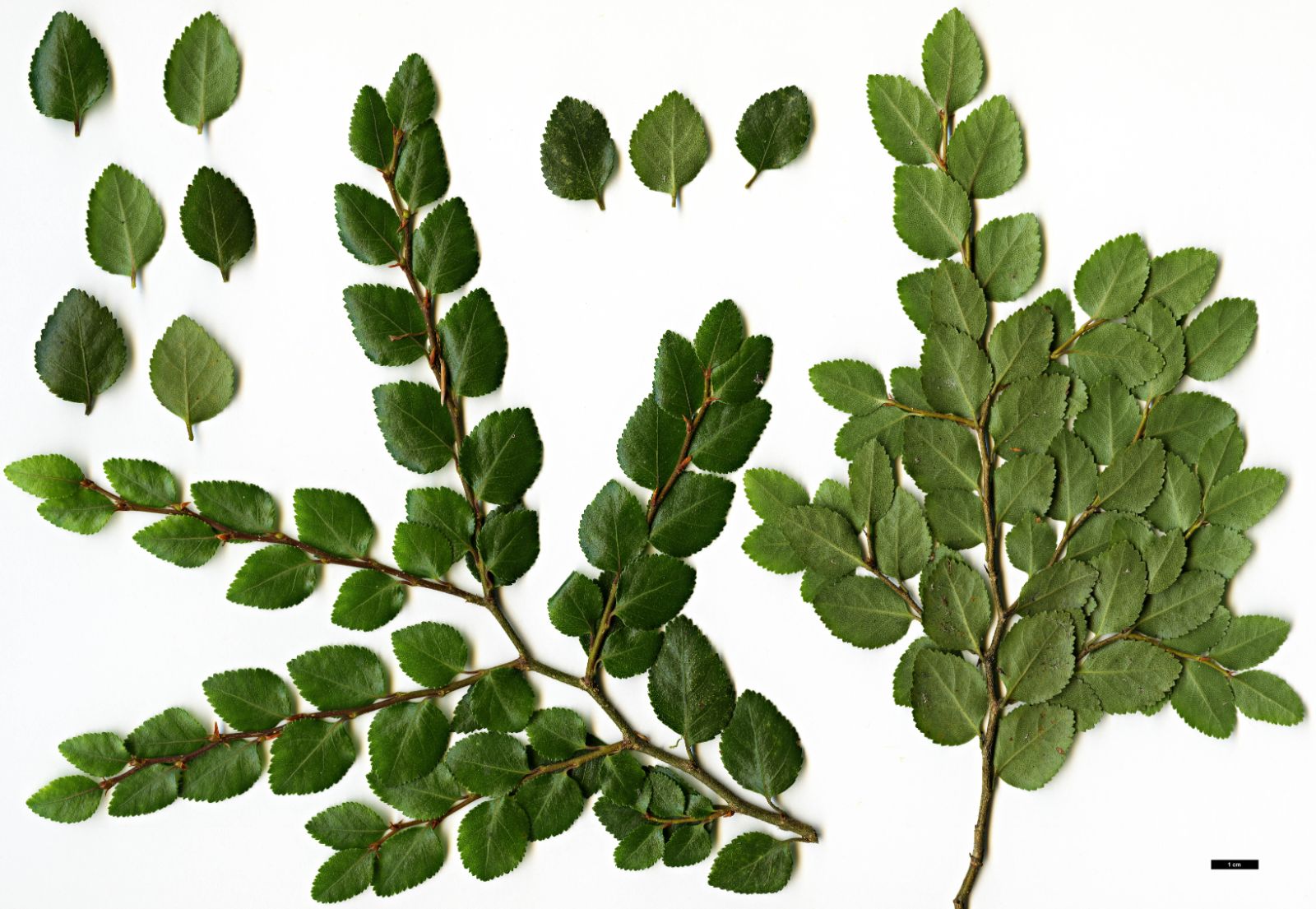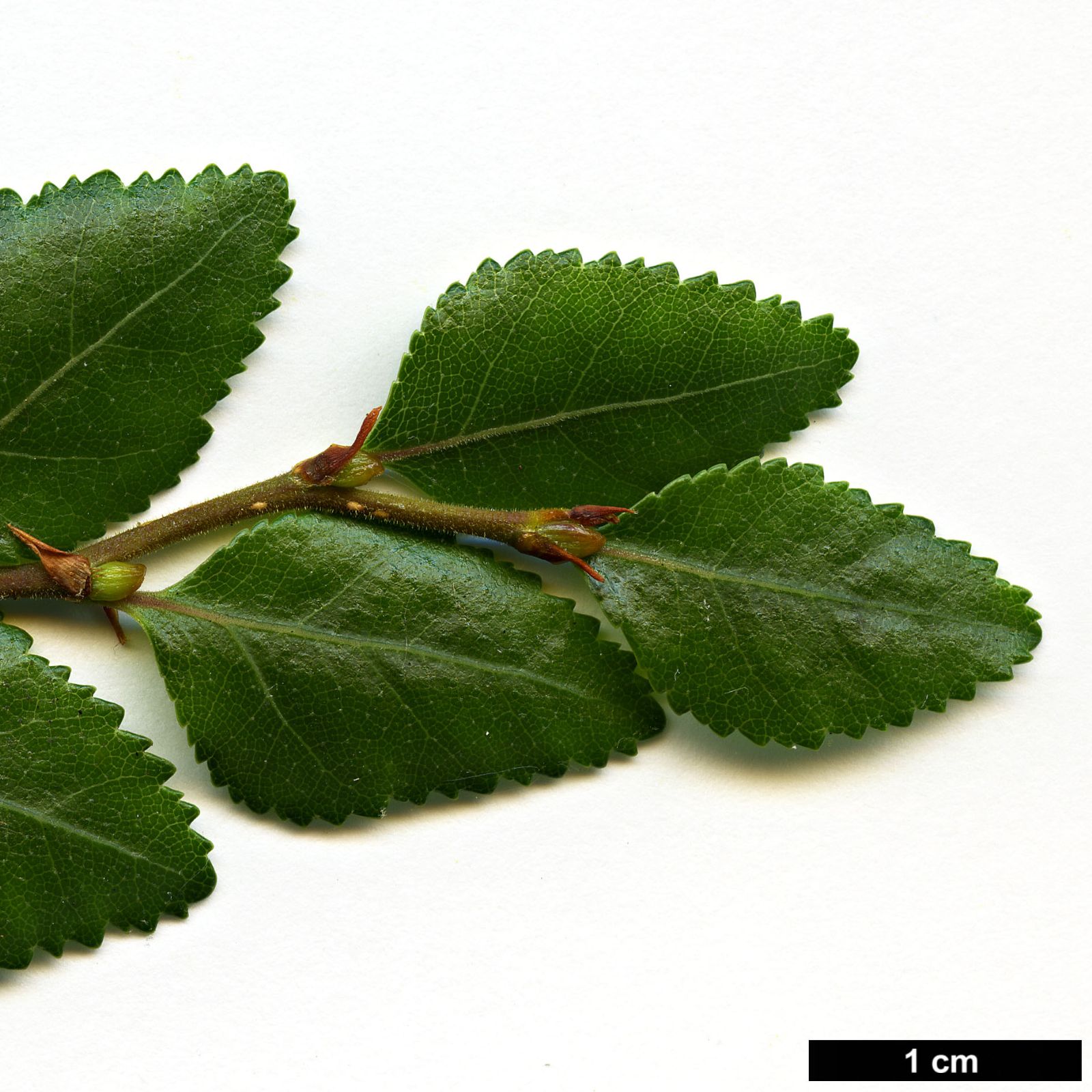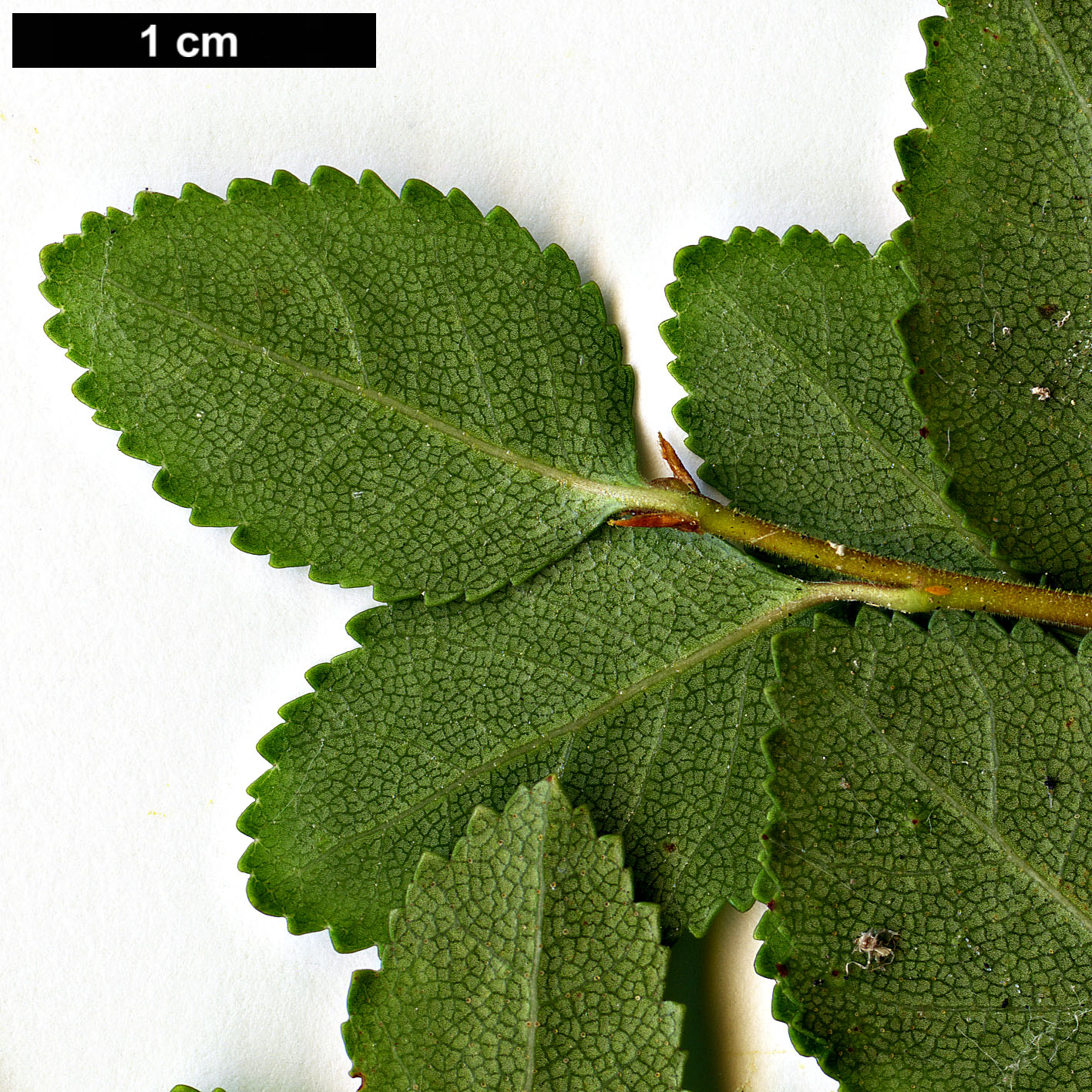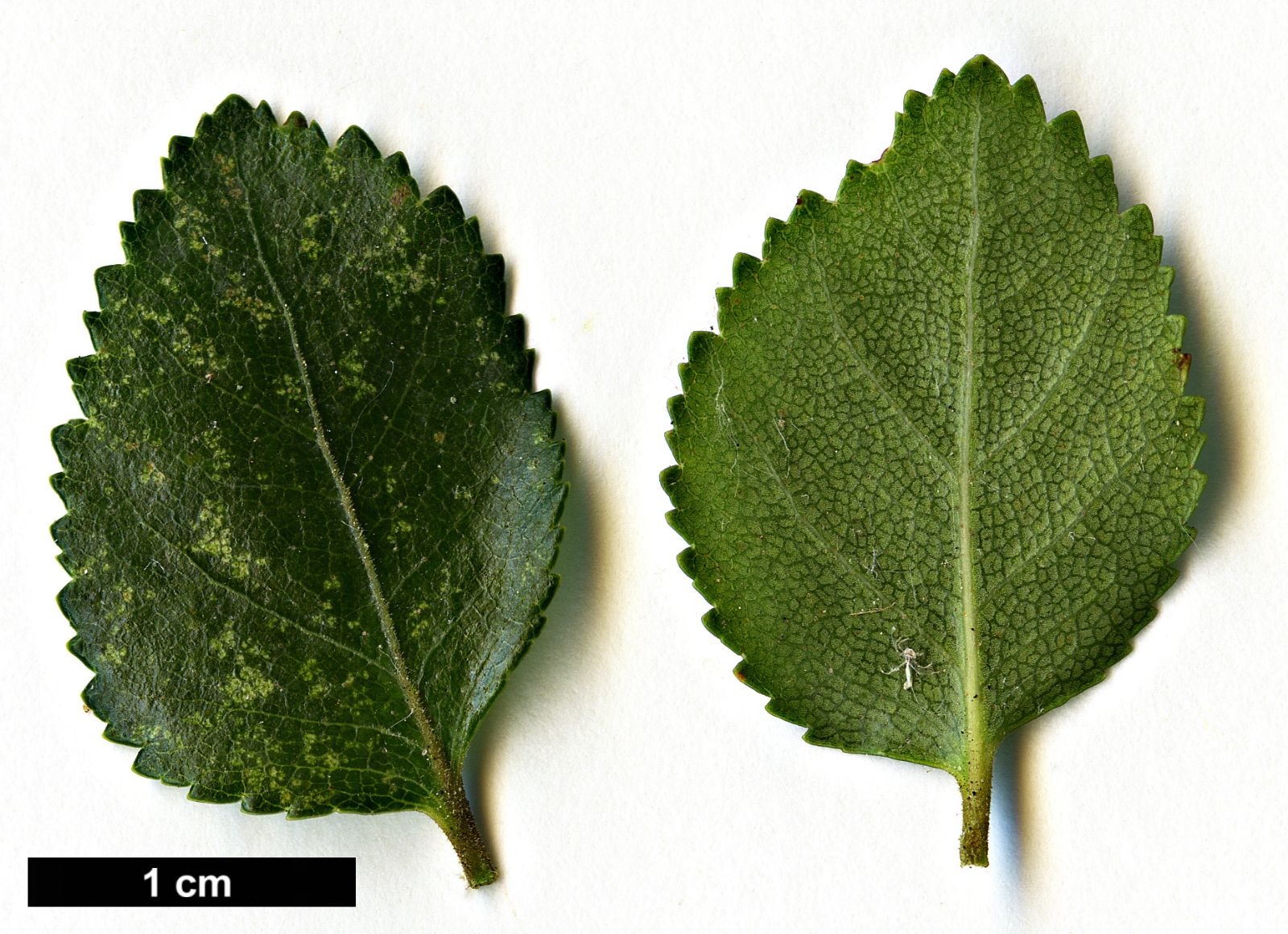Nothofagus betuloides
Sponsor
Kindly sponsored by
Col. Giles Crisp
Credits
Owen Johnson (2020)
Recommended citation
Johnson, O. (2020), 'Nothofagus betuloides' from the website Trees and Shrubs Online (treesandshrubsonline.
Other taxa in genus
- Nothofagus alessandrii
- Nothofagus alpina
- Nothofagus antarctica
- Nothofagus × blairii
- Nothofagus cliffortioides
- Nothofagus cunninghamii
- Nothofagus × dodecaphleps
- Nothofagus dombeyi
- Nothofagus fusca
- Nothofagus glauca
- Nothofagus gunnii
- Nothofagus × leonii
- Nothofagus macrocarpa
- Nothofagus menziesii
- Nothofagus menziesii × obliqua
- Nothofagus moorei
- Nothofagus nitida
- Nothofagus obliqua
- Nothofagus pumilio
- Nothofagus solandri
- Nothofagus truncata
An evergreen tree to 30 m, or a shrub in exposed sites; crown often densely ovoid, with heavy low limbs. Bark reddish grey, horizontally banded with pale lenticels and cracking after about 20 years into jagged, vertical plates. Shoots red-brown, glabrous, slender (1–2 mm thick); buds reddish, conic, about 5 mm long. Leaves borne only about 1 cm apart on the zig-zag shoots; 10–30 × 7–22 mm, ovate, with a rounded base and a finely rounded tip; thick, plane and glossy above; paler beneath and finely net-veined and often sprinkled with minute dark glands; glabrous on both sides; main veins in 5–6 indistinct pairs; marginal teeth fine, slightly irregular and minutely round-tipped; petiole c. 3 mm long. Male flowers born singly, with 6–10(–16) red stamens. Cupules to 1 cm long, with 3 or 4 valves and with short tooth-like lamellae; nutlets weakly winged, with a triple tip. (Nothofagus 2007–2008, Bean 1976).
Distribution Argentina Santa Cruz and Tierra del Fuego Chile Los Lagos, Aysén, Los Ríos and Magallanes regions
Habitat Mountain forests, to 1200 m in the north of its range, avoiding the wettest and most exposed places; to sea-level along the Chilean coastal fringe in the south.
USDA Hardiness Zone 7
RHS Hardiness Rating H5
Conservation status Least concern (LC)
Nothofagus betuloides grows with N. antarctica to the southernmost tip of Cape Horn, while its presence on Hornos Island (Chile) makes it the southernmost tree in the world (Wikipedia 2020); in the wild it can reach ages of 600 years (Nothofagus 2007–2008).
Along with Nothofagus antarctica, N. betuloides is the species most likely to have been collected by Phillip Parker King on his surveying expedition to Magallanes region which returned to Britain in 1830, the year cited by J.C. Loudon shortly afterwards as the date of the first introduction of Nothofagus to Europe (Bean 1976). Both species are known to have been sent as seedlings to Kew in a Wardian case by J.D. Hooker in 1843 (Bean 1976). A tree at Pencarrow in Cornwall, which died in 1925 (Bean 1976), had a recorded planting date of 1847 and is likely to have been grown from seed sent by William Lobb, who collected in Chile for Veitch’s Exeter nursery in the years from 1840. A tree at Hafodunos in north Wales, planted in 1855 and lost some time between 1984 and 2005 (Tree Register 2020), may have derived from the same source and indicates a likely maximum lifespan in Britain; in warm dry regions this will be considerably less.
Through the nineteenth century, Nothofagus betuloides seems to have been the only widely cultivated member of its genus in the UK and Ireland, but it has since lost out in popularity to its more vigorous (but slightly less hardy) close ally N. dombeyi. These species are easily confused, but the more neatly oval shape both of the leaves and the crown of N. betuloides are usually distinctive, while the leaves of N. dombeyi have markedly irregular and very sharp marginal teeth; its male flowers are grouped in threes. Unlike N. dombeyi, N. betuloides remains a tree of quite modest size even in favoured and sheltered gardens; the current champions are at Kitlands in Surrey (16 × 1.04 m dbh in 2012) and at Mount Congreve in Co. Waterford (24 × 0.61 m dbh in 2000) (Tree Register 2020). It is hardy almost everywhere in the UK, and is grown at Olav’s Wood on South Ronaldsay in the Orkneys (Olav’s Wood 2020), though it may not tolerate cold drying winds and, despite its preference for high rainfall, requires a free-draining soil. There are no records of trees thriving for long in gardens over limestone, which may suggest that this species is more strictly calcifuge than most Nothofagus.
Natural regeneration has been noted at Muncaster Castle in Cumbria (Tree Register 2020) – a very wet coastal site with close similarities to the species’ areas of natural distribution.
The species survives near Bergen in south-west Norway, where a trial plantation had reached heights of 7 m after 14 years, and on the Faeroe Islands, where it makes dense low shrubs in extreme exposure; some young trees in Denmark were all killed by cold winters in the 1990s (Søndergaard 1997). There is a small tree at Arboretum Van Tervuren in Belgium (Belgische Dendrologie 2020), and an unhealthy one in the Nothofagus collection at Arboretum Wespelaar (Arboretum Wespelaar 2018). It was planted by the late Bob Berry in Hackfalls Arboretum in New Zealand in 2000 (Hackfalls Arboretum 2020).
The hard, pink-tinged timber, when found in large enough pieces, is used in furniture-making and construction (Wikipedia 2020), but, in the presence of so many more vigorous Nothofagus species, N. betuloides does not seem to have been trialled for forestry in Britain.




